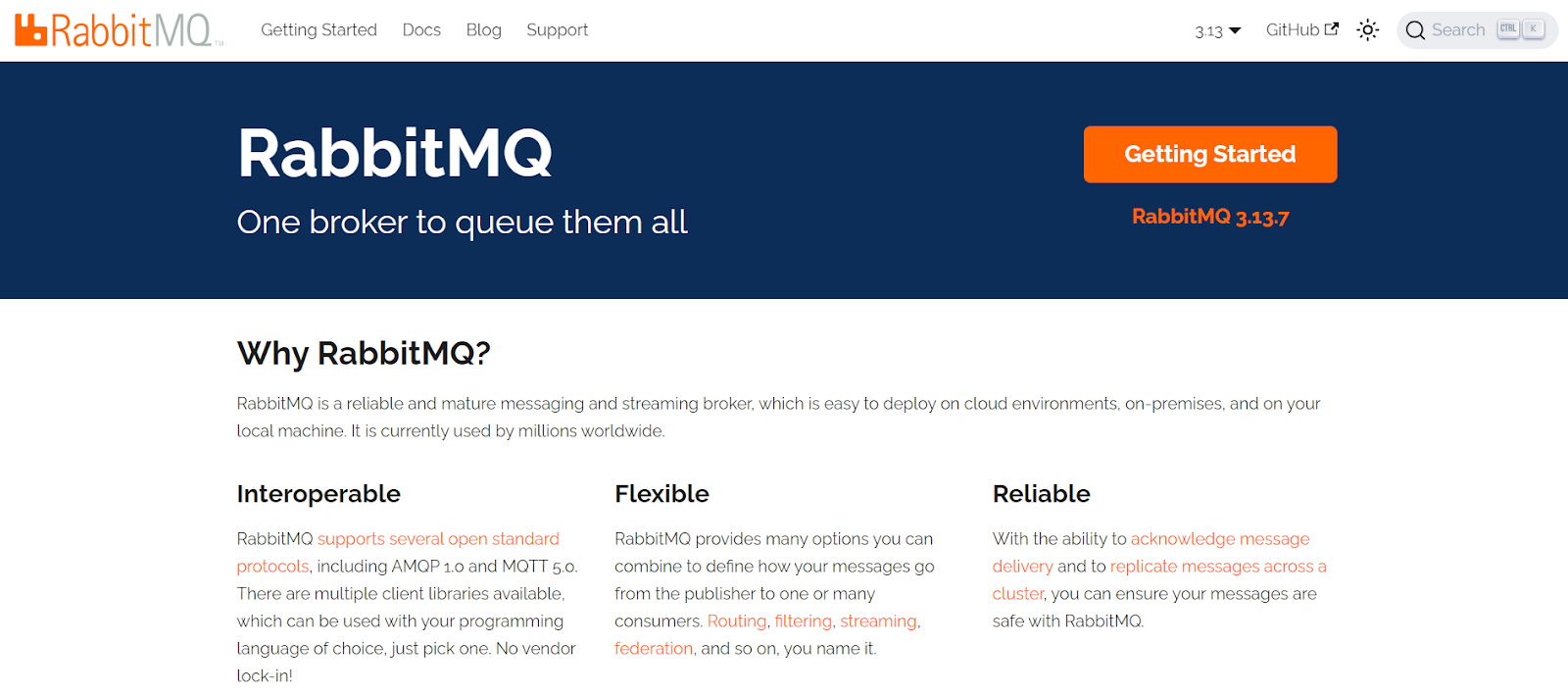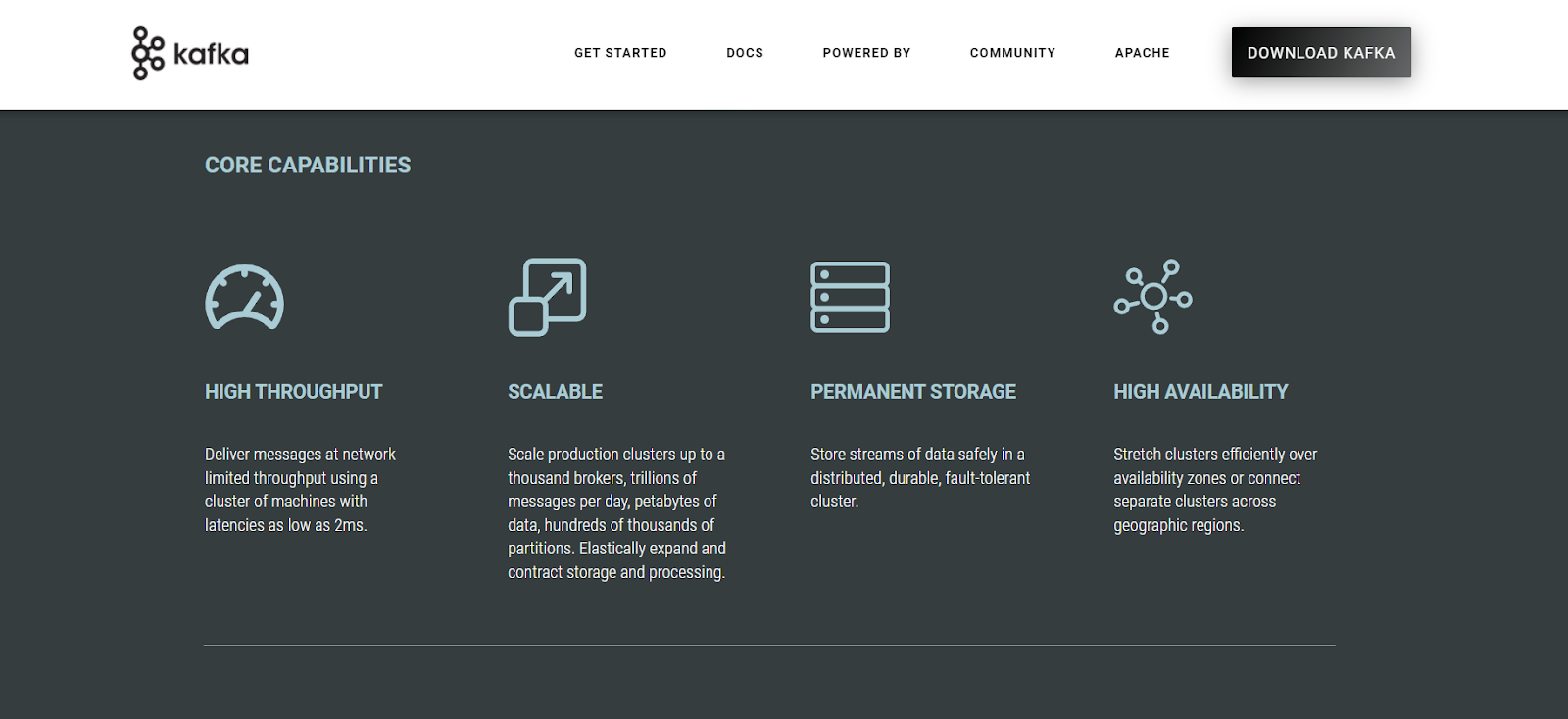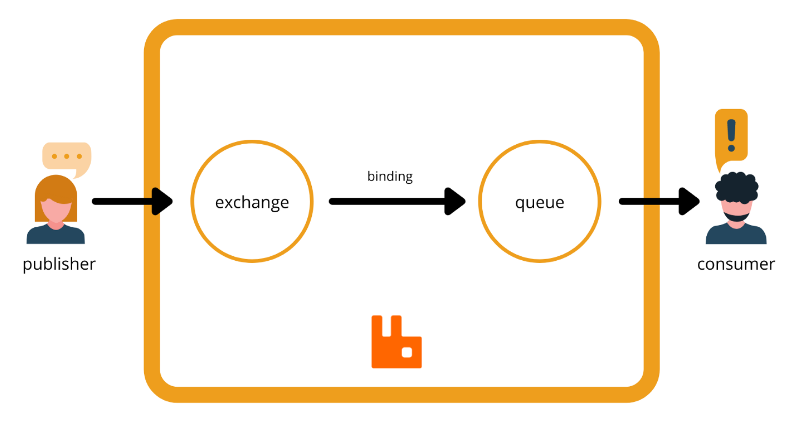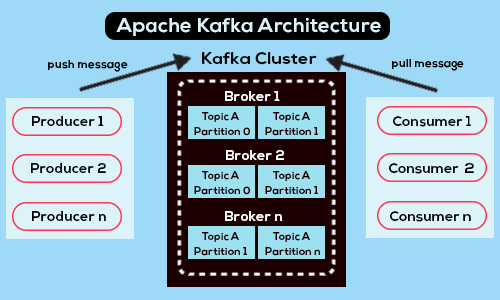RabbitMQ vs Apache Kafka - Key Differences
Summarize this article with:
✨ AI Generated Summary
RabbitMQ and Apache Kafka are leading message brokers with distinct strengths: RabbitMQ excels in reliable delivery, complex routing, and low-latency messaging using a push-based model, while Kafka offers high-throughput, fault-tolerant event streaming with a pull-based model and massive scalability. Key differences include:
- RabbitMQ: Supports multiple protocols (AMQP, MQTT), advanced routing, persistent queues, and suits microservices, task queues, and low-latency apps.
- Kafka: Uses a distributed log architecture with KRaft consensus, ideal for real-time analytics, event sourcing, and high-volume streaming data.
- Recent versions improve fault tolerance—RabbitMQ with Khepri metadata and quorum queues; Kafka by removing ZooKeeper and enhancing consumer group rebalancing.
- Both can be integrated in hybrid architectures, leveraging RabbitMQ for device communication and Kafka for large-scale data pipelines.
If you're building apps that include IoT devices, microservices, or components that depend on reliable communication, you need a message broker. A message broker handles tasks such as validating, routing, storing, and delivering messages, allowing your components to interact with each other without knowing one another's location or status.
The two most popular message brokers are Apache Kafka and RabbitMQ. Each tool has unique strengths, making them suitable for different use cases. This article explores Apache Kafka vs RabbitMQ to help you choose the tool that best aligns with your organization's objectives.
What Is RabbitMQ and How Has It Evolved?
RabbitMQ is a free and open-source distributed message broker that enables you to build a messaging system using HTTP and WebSockets. It operates on Advanced Message Queuing Protocol (AMQP) and supports other protocols like Streaming Text Oriented Messaging Protocol (STOMP) and Message Queuing Telemetry Transport (MQTT). This ensures interoperability with various programming languages and platforms.

With RabbitMQ supporting several messaging patterns, including point-to-point, publish-subscribe, and request-response, 10.9 % of developers surveyed by Stack Overflow prefer RabbitMQ over other platforms. It offers reliable message delivery by facilitating persistent storage, message acknowledgments, and delivery confirmations. RabbitMQ's scalability, flexibility, and enhanced usability make it a good fit for low-latency messaging, task queueing, and event sourcing.
RabbitMQ 4.0 and later versions introduce significant architectural improvements. The platform now supports Khepri as an alternative metadata store using Raft consensus, which provides better fault-tolerant metadata management across distributed clusters. AMQP 1.0 has been elevated to core protocol status, enabling enhanced topology management and cross-protocol interoperability. These updates position RabbitMQ as a more resilient and feature-rich messaging solution for modern distributed systems.
Features of RabbitMQ
- Enhanced Quorum Queues: Replicate queue data across multiple nodes for durability and high availability, now with message priorities and checkpoint-based recovery for faster startup
- Flexible Routing Options: Route messages through direct, topic, and fan-out exchanges or create custom exchange types, including the new Local Random Exchange for probabilistic routing
- Built-in Clustering: Form clusters of multiple nodes for redundancy, fault tolerance, and horizontal scaling with improved Khepri metadata management
- Work Queues: Offload I/O-intensive tasks to dedicated worker processes to improve responsiveness with optimized memory efficiency
- Firehose Tracer: Capture and trace every message routed through the broker for comprehensive monitoring and troubleshooting
What Is Apache Kafka and What Are Its Latest Capabilities?
Apache Kafka is a no-cost, open-source distributed event-streaming platform optimized for high-throughput, low-latency message delivery and processing. It operates on a binary protocol over TCP. Kafka uses a publish-subscribe model, enabling producers to send messages to Kafka topics (categories used to organize messages) and store them until subscribers consume them.

Kafka integrates well with other tools and systems, making it easy to incorporate into existing data workflows. Its ability to partition data across multiple servers helps you handle high-velocity streaming data with negligible overhead. Kafka also offers high durability, fault tolerance, and recovery mechanisms to prevent unexpected data loss.
Apache Kafka 4.0 represents a major architectural shift with the complete removal of ZooKeeper dependency in favor of KRaft (Kafka Raft) as the sole consensus mechanism. This simplifies deployment by eliminating the need for external ZooKeeper ensembles while reducing operational overhead. The platform now supports tiered storage for extended retention, queue semantics via KIP-932 for traditional point-to-point messaging patterns, and enhanced consumer group rebalancing protocols that minimize downtime during group changes.
Features of Apache Kafka
- KRaft-First Architecture: Eliminates ZooKeeper dependency with native Raft-based consensus for simplified deployment and reduced operational complexity
- Advanced Tiered Storage: Enables colocated primary and archive storage tiers for cost-effective data retention and duration-based offset resets
- Queue Semantics Support: Provides traditional point-to-point messaging patterns with shared consumer groups and individual acknowledgments
- Enhanced Consumer Group Protocol: Implements cooperative rebalancing that removes global synchronization barriers and minimizes service disruption
- Multi-Tenancy Support: Securely isolate workloads so multiple producers or consumers can share a cluster with improved RBAC and resource management
What Are the Key Architectural Differences Between RabbitMQ and Apache Kafka?
The main difference is that RabbitMQ is a message broker designed for reliable message delivery and complex routing, while Kafka is a distributed event-streaming platform optimized for high-throughput, fault-tolerant data pipelines.
RabbitMQ Architecture
RabbitMQ follows a conventional messaging architecture suitable for complex routing scenarios and lower message volumes. The modern architecture leverages quorum queues with Raft consensus for improved reliability and Khepri metadata storage for better distributed coordination.

Key components: Producer, Routing Key, Exchange, Queue, Binding, Consumer.
The architecture emphasizes smart brokers that handle complex routing logic, message persistence, and delivery guarantees. Exchanges determine message routing patterns while queues provide durable storage with configurable replication across cluster nodes.
Apache Kafka Architecture
Kafka is designed around a distributed, log-based architecture that prioritizes horizontal scalability and throughput. The KRaft-based architecture eliminates external dependencies while maintaining high availability and fault tolerance.

Key components: Producers, Topics, Partitions, Brokers, Consumers, KRaft Controllers (replacing ZooKeeper).
This architecture follows a dumb broker, smart consumer model where brokers provide simple append-only log storage while consumers manage their own state and message processing logic. The distributed nature enables massive horizontal scaling through partition distribution across broker clusters.
How Do Kafka vs. RabbitMQ Differ in Message Handling Approaches?
Message handling represents one of the most fundamental differences between these platforms, affecting everything from performance characteristics to application design patterns.
What Are the Performance and Scalability Differences Between Apache Kafka vs. RabbitMQ?
Performance characteristics vary dramatically between these platforms, making them suitable for different operational requirements and scale demands.
- RabbitMQ typically handles thousands to tens of thousands of messages per second with sub-millisecond latency for low-throughput workloads. Its strength lies in reliable delivery guarantees and complex routing capabilities rather than raw throughput performance. The platform excels in scenarios requiring guaranteed message delivery and sophisticated routing patterns.
- Kafka processes millions of messages per second per broker with approximately 5ms p99 latency at scale. The platform's log-based architecture enables massive horizontal scaling through partition distribution, making it ideal for high-volume streaming applications and real-time analytics pipelines.
How Do Advanced Deployment Patterns and Cloud-Native Architectures Leverage These Technologies?
Modern deployment strategies emphasize serverless computing, event-driven architectures, and hybrid cloud implementations that maximize the unique strengths of both messaging platforms.
Serverless and Event-Driven Integration Patterns
Kubernetes and cloud-native platforms use RabbitMQ and Kafka as messaging backbones for serverless functions. Kafka integrates with Knative for scale-to-zero functionality, enabling elastic resource utilization for IoT services and real-time processing.Event mesh architectures unify messaging systems under a single routing layer. Federated topologies allow Kafka and RabbitMQ clusters to interoperate, enabling gradual migration without infrastructure lock-in.
RabbitMQ excels in low-payload, high-trust scenarios like banking notifications requiring individual message tracking.
Hybrid Cloud and Multi-Region Deployments
Advanced deployment patterns address data sovereignty and global scalability through sophisticated replication. RabbitMQ's federation policies automate multi-cloud configurations, while shovel plugins enable bidirectional synchronization. Kafka's cross-cluster mirroring supports multi-region deployments with strong consistency guarantees and disaster recovery capabilities.
Data integration platforms like Airbyte bridge these messaging systems with broader infrastructure, routing data through RabbitMQ for real-time processing or Kafka for analytics.
When Should You Choose RabbitMQ for Your Architecture?
RabbitMQ serves as the optimal choice for scenarios requiring sophisticated message routing, reliable delivery guarantees, and integration with existing enterprise systems.
- Complex Routing Requirements: Route messages based on content, destination, or custom business logic through flexible exchange and binding configurations.
- Task Queueing and Background Processing: Handle background jobs such as image scaling, video encoding, or batch processing with guaranteed task completion.
- Microservices Communication: Serve as a reliable message queue between microservices requiring transactional messaging and delivery confirmations.
- Legacy System Integration: Connect with existing enterprise systems through multiple protocol support, including MQTT, STOMP, and HTTP endpoints.
- Low-Latency Real-Time Applications: Deliver sub-millisecond latency for time-sensitive applications like trading systems or real-time user notifications.
When Should You Choose Apache Kafka for Your Architecture?
Apache Kafka excels in high-throughput scenarios:
- Stream Processing and Real-Time Analytics: Collect and process large volumes of streaming data in real-time for applications like fraud detection or recommendation engines
- Event Sourcing and Audit Trails: Store and replay state changes over time while maintaining immutable event logs for compliance and debugging
- Log Aggregation and Centralized Monitoring: Replace file-based logging with durable, low-latency streams that support multiple consumer patterns
- High-Throughput Data Pipelines: Handle millions of messages per second across distributed systems with horizontal scaling through partitioning
- IoT and Sensor Data Processing: Ingest massive volumes of telemetry data from devices and sensors for real-time analysis and historical storage
Conclusion
Choosing between RabbitMQ and Kafka depends primarily on your specific use case requirements. RabbitMQ excels in scenarios requiring complex routing, reliable delivery, and diverse protocol support. Kafka dominates high-throughput streaming applications with its scalable, distributed architecture and long-term message retention.
Both technologies continue to evolve with architectural improvements that address previous limitations while maintaining their core strengths.
Frequently Asked Questions
1. What are the main performance differences between RabbitMQ and Kafka?
RabbitMQ typically handles thousands to tens of thousands of messages per second with sub-millisecond latency for low-throughput workloads, while Kafka processes millions of messages per second per broker with approximately 5ms p99 latency at scale. Kafka excels in high-throughput scenarios, while RabbitMQ provides superior performance for complex routing and guaranteed delivery requirements.
2. How do the latest versions of RabbitMQ and Kafka improve reliability?
RabbitMQ 4.0+ introduces Khepri metadata storage with Raft consensus for better fault tolerance and enhanced quorum queues with checkpoint-based recovery. Kafka 4.0+ eliminates ZooKeeper dependency through KRaft architecture and implements cooperative consumer group rebalancing to minimize service disruptions during scaling events.
3. Can I use both RabbitMQ and Kafka in the same architecture?
Yes, many organizations use both technologies strategically. RabbitMQ handles microservices communication and complex routing scenarios, while Kafka manages high-volume streaming data and analytics pipelines. Data integration platforms can help bridge these systems and manage data flow between different messaging architectures.
4. Which platform is better for IoT applications?
The choice depends on your IoT requirements. RabbitMQ excels for device communication requiring reliable delivery and complex routing, especially with MQTT protocol support. Kafka is superior for ingesting massive sensor data volumes and real-time analytics. Many IoT architectures use RabbitMQ for device-to-gateway communication and Kafka for data aggregation and processing.
5. How do deployment and operational complexity compare between the platforms?
Kafka's KRaft architecture simplifies deployment by eliminating ZooKeeper dependencies, while RabbitMQ's clustering and federation capabilities provide flexible deployment options. Both platforms offer managed cloud services that reduce operational overhead, though Kafka generally requires more expertise for optimization and troubleshooting in distributed environments.

.webp)
